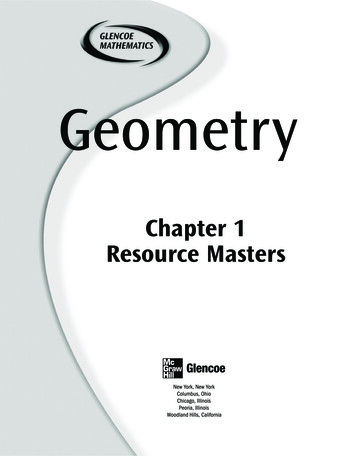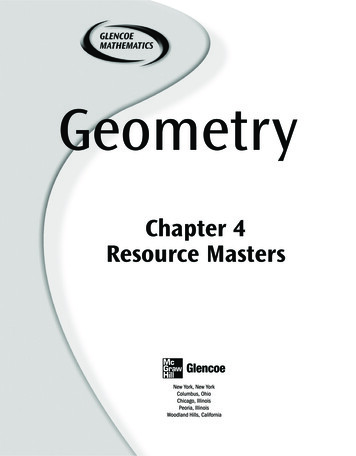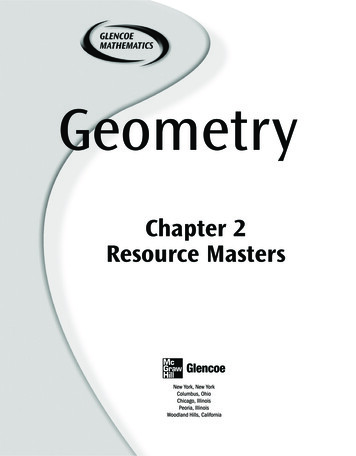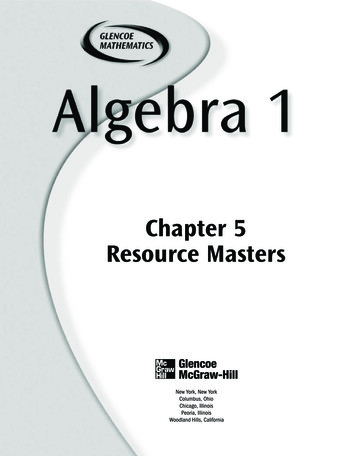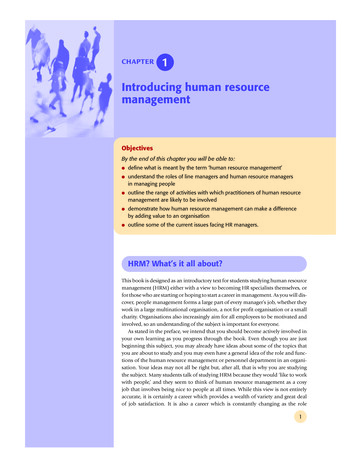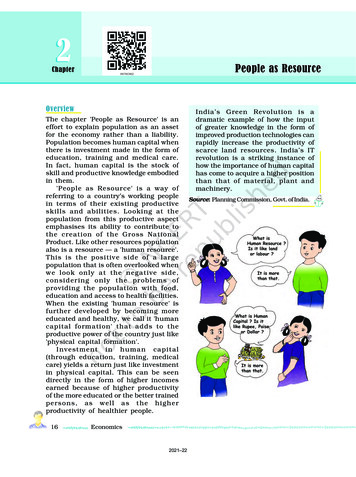
Transcription
2People as ResourceChapterOverviewThe chapter 'People as Resource' is aneffort to explain population as an assetfor the economy rather than a liability.Population becomes human capital whenthere is investment made in the form ofeducation, training and medical care.In fact, human capital is the stock ofskill and productive knowledge embodiedin them.'People as Resource' is a way ofreferring to a country’s working peoplein terms of their existing productiveskills and abilities. Looking at thepopulation from this productive aspectemphasises its ability to contribute tothe creation of the Gross NationalProduct. Like other resources populationalso is a resource — a 'human resource'.This is the positive side of a largepopulation that is often overlooked whenwe look only at the negative side,considering only the problems ofproviding the population with food,education and access to health facilities.When the existing 'human resource' isfurther developed by becoming moreeducated and healthy, we call it 'humancapital formation' that adds to theproductive power of the country just like'physical capital formation'.Investment in human capital(through education, training, medicalcare) yields a return just like investmentin physical capital. This can be seendirectly in the form of higher incomesearned because of higher productivityof the more educated or the better trainedpersons, as well as the higherproductivity of healthier people.16Economics2021–22India’s Green Revolution is adramatic example of how the inputof greater knowledge in the form ofimproved production technologies canrapidly increase the productivity ofscarce land resources. India’s ITrevolution is a striking instance ofhow the importance of human capitalhas come to acquire a higher positionthan that of material, plant andmachinery.Source: Planning Commission, Govt. of India.
population need not be a burden for theeconomy. It can be turned into aproductive asset by investment in humancapital (for example, by spendingresources on education and health for all,training of industrial and agriculturalworkers in the use of modern technology,useful scientific researches and so on).The two following cases illustrate howpeople can try to become a more productiveresource:Story of SakalPicture 2.1Let’s Discuss Looking at the photograph can youexplain how a doctor, teacher, engineerand a tailor are an asset to theeconomy?Not only do the more educated and thehealthier people gain through higherincomes, society also gains in otherindirect ways because the advantages of amore educated or a healthier populationspreads to those also who themselves werenot directly educated or given health care.In fact, human capital is in one waysuperior to other resources like land andphysical capital: human resource canmake use of land and capital. Land andcapital cannot become useful on its own!For many decades in India, a largepopulation has been considered a liabilityrather than an asset. But a largeThere were two friends Vilas andSakal living in the same villageSemapur. Sakal was a twelve-yearold boy. His mother Sheela lookedafter domestic chores. His father ButaChaudhary worked in an agriculturalfield. Sakal helped his mother indomestic chores. He also looked afterhis younger brother Jeetu and sisterSeetu. His uncle Shyam had passedthe matriculation examination, but,was sitting idle in the house as hehad no job. Buta and Sheela wereeager to teach Sakal. They forced himto join the village school which hesoon joined. He started studying andcompleted his higher secondaryexamination. His father persuadedhim to continue his studies. He raiseda loan for Sakal to study a vocationalcourse in computers. Sakal wasmeritorious and interested in studiesfrom the beginning. With great vigourand enthusiasm he completed hiscourse. After some time he got a jobin a private firm. He even designed anew kind of software. This softwarehelped him increase the sale of thefirm. His boss acknowledged hisservices and rewarded him with apromotion.People as Resource2021–2217
Picture 2.2 Stories of Vilas and SakalLet’s DiscussStory of VilasVilas was an eleven-year old boyresiding in the same village as Sakal.Vilas’s father Mahesh was afisherman. His father passed awaywhen he was only two years old. Hismother Geeta sold fish to earn moneyto feed the family. She bought fishfrom the landowner’s pond and soldit in the nearby mandi. She couldearn only Rs 150 a day by selling fish.Vilas became a patient of arthritis.His mother could not afford to takehim to the doctor. He could not go toschool either. He was not interestedin studies. He helped his mother incooking and also looked after hisyounger brother Mohan. After sometime his mother fell sick and therewas no one to look after her. Therewas no one in the family to supportthem. Vilas, too, was forced to sellfish in the same village. He like hismother earned only a meagreincome.18Economics2021–22 Do you notice any difference betweenthe two friends? What are those?ActivityVisit a nearby village or a slum areaand write down a case study of a boyor girl of your age facing the samecondition as Vilas or Sakal.In the two case studies we saw Sakalwent to school and Vilas did not go. Sakalwas physically strong and healthy. Therewas no need for him to visit the doctorfrequently. Vilas was a patient ofarthritis. He lacked the means to visitthe doctor. Sakal acquired a degree incomputer programming. Sakal found ajob in a private firm while Vilascontinued with the same work as hismother. He earned a meagre income likehis mother to support a family.In the case of Sakal, several years ofeducation added to the quality of labour.This enhanced his total productivity.Total productivity adds to the growth ofthe economy. This in turn pays an
individual through salary or in some otherform of his choice. In case of Vilas, therecould not be any education or health carein the early part of his life. He spendshis life selling fish like his mother.Henceforth, he draws the same salary ofunskilled labourer as his mother.Investment in human resource (viaeducation and medical care) can give highrates of return in future. This investmenton people is the same as investment inland and capital.A child, too, with investments madeon her education and health, can yielda high return in future in the form ofhigherearningsandgreatercontribution to the society. Educatedparents are found to invest more heavilyon the education of their child. This isbecause they have realised theimportance of education for themselves.They are also conscious of propernutrition and hygiene. They accordinglylook after their children’s needs foreducation at school and good health. Avirtuous cycle is, thus, created in thiscase. In contrast, a vicious cycle maybe created by disadvantaged parents,who themselves uneducated and lackingin hygiene, keep their children in asimilarly disadvantaged state.Countries, like Japan, have investedin human resource. They did not have anynatural resource. These countries aredeveloped/rich. They import the naturalresource needed in their country. How didthey become rich/developed? They haveinvested on people, especially in the fieldof education and health. These peoplehave made efficient use of other resources,like land and capital. Efficiency and thetechnology evolved by people have madethese countries rich/developed.Economic Activities by Men and WomenLike Vilas and Sakal, people have beenengaged in various activities. We saw thatVilas sold fish and Sakal got a job in thefirm. The various activities have beenclassified into three main sectors i.e.,primary, secondary and tertiary. Primarysector includes agriculture, forestry,animal husbandry, fishing, poultryfarming, mining and quarrying.Manufacturing is included in thesecondary sector. Trade, transport,communication, banking, education,health, tourism, services, insurance, etc.are included in the tertiary sector. Theactivities in this sector result in theproduction of goods and services. Theseactivities add value to the nationalincome. These activities are calledeconomic activities. Economic activitieshave two parts — market activities andnon-market activities. Market activitiesinvolve remuneration to anyone whoperforms i.e., activity performed for payor profit. These include production of goodsor services, including government service.Non-market activities are the productionfor self-consumption. These can bePicture 2.3 Based on the picture can you classifythese activities into three sectors?People as Resource2021–2219
consumption and processing of primaryproduct and own account production offixed assets.ActivityVisit a village or colony located nearto your residential area and notedownthevariousactivitiesundertaken by the people of thatvillage or colony.If this is not possible, ask yourneighbour what is their profession?In which of the three sectors will youcategorise their work?Say whether these activities areeconomic or non-economic activities:Vilas sells fish in the village market.Vilas cooks food for his family.Sakal works in the private firm.Sakal looks after his younger brotherand sister.Due to historical and cultural reasonsthere is a division of labour between menand women in the family. Womengenerally look after domestic chores andmen work in the fields. Sakal’s motherSheela cooks food, cleans utensils, washesclothes, cleans the house and looks afterher children. Sakal’s father Butacultivates the field, sells the produce inthe market and earns money for the family.Sheela is not paid for the servicesdelivered for upbringing of the family.Buta earns money, which he spends onrearing his family. Women are not paidfor their service delivered in the family.The household work done by women isnot recognised in the National Income.Geeta, mother of Vilas, earned anincome by selling fish. Thus women arepaid for their work when they enter thelabour market. Their earning like that oftheir male counterpart is determined onthe basis of education and skill.20Economics2021–22Education helps individual to make betteruse of the economic opportunitiesavailable before him. Education and skillare the major determinants of the earningof any individual in the market. A majorityof women have meagre education and lowskill formation. Women are paid lowcompared to men. Most women workwhere job security is not there. Variousactivities relating to legal protection ismeagre. Employment in this sector ischaracterised by irregular and lowincome. In this sector there is an absenceof basic facilities like maternity leave,childcare and other social securitysystems. However, women with higheducation and skill formation are paid atpar with the men. Among the organisedsector, teaching and medicine attractthem the most. Some women have enteredadministrative and other servicesincluding job, that need high levels ofscientific and technological competence.Ask your sister or your classmate whatshe would like to take up as a career?Quality of PopulationThe quality of population depends uponthe literacy rate, health of a personindicated by life expectancy and skillformation acquired by the people of thecountry. The quality of the poulationultimately decides the growth rate of thecountry. Literate and healthy populationare an asset.EducationSakal’s education in the initial years ofhis life bore him the fruits in the lateryears in terms of a good job and salary.We saw education was an important inputfor the growth of Sakal. It opened newhorizon for him, provided new aspirationand developed values of life. Not only forSakal, education contributes towards thegrowth of society also. It enhances the
.human being is a positive asset anda precious national resource whichneeds to be cherished, nurtured anddeveloped with tenderness and care,coupled with dynamism. Eachindividual’s growth presents adifferent range of problems andrequirements. . The catalytic actionof education in this complex anddynamic growth process needs to beplanned meticulously and executedwith great sensitivity.Picture 2.4 School childrennational income, cultural richness andincreases the efficiency of governance.There is a provision made for providinguniversal access, retention and quality inSource: National Education Policy, 1986.Graph 2.1: Trends in Literacy Rates In Post-Independent India908070Literacy 11991200120112017YearSource: Census of India, Office of Registrar General, India, indi-2019)elementary education with a specialemphasis on girls. There is also anestablishment of pace setting of schoolslike Navodaya Vidyalaya in each district.Vocational streams have been developedto equip large number of high schoolstudents with occupations related toknowledge and skills. The plan outlay oneducation has increased from Rs 151 crorein the first plan to Rs 99,300 crore in2020–21. The expenditure on education asa percentage of GDP rose from 0.64% in1951–52 to 3.1% in 2019–20 (B.E.) andhas remained stagnant around 3% frompast few years. The Budgetary EstimateLet’s DiscussStudy the graph and answer the followingquestions:1. Has the literacy rates of the populationincreased since 1951?2. In which year India has the highestliteracy rates?3. Why literacy rate is high among themales of India?4. Why are women less educated than men?5. How would you calculate literacy ratein India?6. What is your projection about India’sliteracy rate in 2025?People as Resource2021–2221
ActivityCount the number of boys and girlsstudying in your school or in yourneighbouring co-ed school.Ask the school administrator toprovide you with the data of boys andgirls studying in the classroom. Studythe difference if any and explain forreasons in the classroom.as stated in the Budget Documents ofUnion State Governments, Reserve Bankof India, the expenditure on education asa percentage of GDP has declined to 2.7%in 2017–18 (B.E.) The literacy rates haveincreased from 18% in 1951 to 85% in2017. Literacy is not only a right, it is alsoneeded if the citizens are to perform theirduties and enjoy their rights properly.However, a vast difference is noticed acrossdifferent sections of the population.Literacy among males is nearly 14.4%higher than females and it is about 14.2%higher in urban areas as compared to ruralareas. In 2017–18, literacy rates variedfrom 96.2% in Kerala to 70.9% in Bihar.The primary school system has expandedto over 8.41 lakh in 2015–16.Unfortunately, this huge expansion ofschools has been diluted by the poorquality of schooling and high dropoutrates. “Sarva Siksha Abhiyan is asignificant step towards providingelementary education to all children in theage group of 6–14 years by 2010. It is atime-bound initiative of the Centralgovernment, in partnership with theStates, the local government and thecommunity for achieving the goal ofuniversalisation of elementary education.”Along with it, bridge courses and backto-school camps have been initiated toincrease the enrolment in elementaryeducation. Mid-day meal scheme has beenimplemented to encourage attendance andretention of children and improve theirnutritional status. These policies couldadd to the literate population of India.The Gross Enrolment Ratio (GER) inhigher education in the age group of 18to 23 years is 26.3% in 2018–19, whichwould be broadly in line with worldaverage. The strategy focuses onincreasing access, quality, adoption ofstate-specific curriculum modification,vocationalisation and networking on theuse of information technology. There isalso focuse on distance education,convergence of formal, non-formal,distance and IT education institutions.Table 2.1: Number of Institutions of Higher Education, Enrolment and FacultyYearNumber ofCollegesNumber ofUniversitiesStudents1950 – 511990 – 911998 – 992010 –112012 –132014 –152015 –162016 9,388Teachers in Universities& 1,35014,38,00014,70,190*12,84,95714,16,299Source: UGC Annual Report 2010–11, 2012–13, 2013–14, 2015–16 and SelectedEducational Statistics, Ministry of HRD.www.ugc.ac.in Annual Report. 2018–19.pdf*Provisional Data from All India Survey on Higher Education, 2017–18, 2018–19.22Economics2021–22
Over the past 60 years, there has been asignificant growth in the number ofuniversity and institutions of higherlearning in specialised areas. Let us readthe table to see the increase in thenumber of college, universities, enrolmentof students and recruitment of teachersfrom 1951 to 2018–19.Let’s DiscussDiscuss this table in the classroom andanswer the following questions.1. Is the increase in the number ofcolleges adequate to admit theincreasing number of students?2. Do you think we should have morenumber of universities?3. What is the increase noticed among theteachers in the year 2015–16.4. What is your idea about future collegesand universities?HealthFirm maximise profit: Do you think anyfirm would be induced to employ peoplewho might not work efficiently as healthyworkers because of ill health?The health of a person helps him torealise his/her potential and the abilityto fight illness. He/She will not be ableto maximise his/her output to the overallgrowth of the organisation. Indeed; healthis an indispensable basis for realising one’swell-being. Henceforth, improvement in thehealth status of the population has beenthe priority of the country. Our nationalpolicy, too, aims at improving theaccessibility of healthcare, family welfareand nutritional service with a special focuson the underprivileged segment of thepopulation. Over the last five decades,India has built a vast healt infrastructureand has also developed the manpowerrequired at primary, secondary andtertiary sector in government, as well as,in the private sector.These measures, which have beenadopted, have increased the lifeexpectancy to over 68.3 years in 2016.*Infant mortality rate (IMR) has comedown from 147 in 1951 to 34 in 2016.**Crude birth rates have dropped to20.4 and ***death rates to 6.4 withinthe same duration of time. Increase inlife expectancy and improvement inchildcare are useful in assessing thefuture progress of the country. Increasein longevity of life is an indicator of goodquality of life marked by self-confidence.Reduction in infant mortality involvesthe protection of children from infection,ensuring the nutrition of both themother and the child, and childcare.Source: National Health Profile, 2019Let’s DiscussPicture 2.5 Children standing in queue forhealth check-upStudy Table 2.2 and answer the followingquestions.1. What is the percentage increase indispensaries from 1951 to 2020?2. What is the percentage increase indoctors and nursing personnel from1951 to 2020?* Infant mortality rate is the death of a child below one year of age.** Birth rates is the number of babies born for every 1,000 people during a particular period of time.*** Death rate is the number of people per 1,000 who die during a particular period of time.People as Resource2021–2223
Table 2.2: Health infrastructure over the 185,933187,505189,784Dispensariesand Hospitals29,71529,95730,04431,64131,733Beds red Doctor inMedical Council36,35541,71144,93443,58141,371Nursing Personnel(ANM RN&RM C: Sub centre, PHC: Primary Health Centre, CHC: Community Health Centre. ANM: AuxiliaryNurse Hydrides, RN&RM: Registered Nurses & Registered Midwives, LHV: Lady Health Visitors.Source: National Health Policy, 2013, 2014, 2015, (National Health Profile, 2016, 2017, 2018, CentralBureau of Health Intelligence, Ministry of Health and Family Welfare.)3. Do you think the increase in thenumber of doctors and nurses isadequate for India? If not, why?4. What other facilities would you like toprovide in a hospital?5. Discuss about the hospital you havevisited?6. Can you draw a graph using this table.There are many places in India whichdo not have even these basic facilities.There are only 529 medical colleges in thecountry and 313 dental colleges. Just fourstates, like Andhra Pradesh, Karnataka,Maharastra and Tamil Nadu have themaximum number of colleges.ActivityVisit a nearby hospital, eithergovernment or private and note downthe following details.How many beds are there in thehospital you have visited?24Economics2021–22How many doctors are there in thehospital?How many nurses work in thathospital?Besides, try to gather the followingadditional information:How many hospitals are there in yourlocality?How many dispensaries are there inyour locality?UnemploymentSakal’s mother Sheela looked after thedomestic chores, children and helped herhusband Buta in the field. Sakal’sbrother, Jeetu, and sister, Seetu, spendtheir time playing and roaming. Can youcall Sheela or Jeetu or Seetuunemployed? If not, why?Unemployment is said to exist whenpeople who are willing to work at the goingwages cannot find jobs. Sheela is notinterested in working outside her
domestic domain. Jeetu and Seetu are toosmall to be counted in the work forcepopulation. Neither Jeetu, Seetu or Sheelacan be counted as unemployed. Theworkforce population includes people from15 years to 59 years. Sakal’s brother andsister do not fall within this age group sothey cannot be called unemployed. Sakal’smother Sheela works for the family. Sheis not willing to work outside her domesticdomain for payment. She too cannot becalled unemployed. Sakal’s grandparents(although not mentioned in the story)cannot be called unemployed.In case of India we have unemploymentin rural and urban areas. However, thenature of unemployment differs in ruraland urban areas. In case of rural areas,there is s e a s o n a l and d i s g u i s e dunemployment. Urban areas have mostlyeducated unemployment.Seasonal unemployment happenswhen people are not able to find jobsduring some months of the year. Peopledependant upon agriculture usually facesuch kind of problem. There are certainbusy seasons when sowing, harvesting,weeding and threshing is done. Certainmonths do not provide much work to thepeople dependant on agriculture.In case of disguised unemploymentpeople appear to be employed. They haveagricultural plot where they find work.This usually happens among familymembers engaged in agricultural activity.The work requires the service of fivepeople but engages eight people. Threepeople are extra. These three people alsowork in the same plot as the others. Thecontribution made by the three extrapeople does not add to the contributionmade by the five people. If three peopleare removed the productivity of the fieldwill not decline. The field requires theservice of five people and the three extrapeople are disguised unemployed.In case of urban areas educatedunemployment has become a commonphenomenon.Manyyouthwithmatriculation, graduation and postgraduation degrees are not able to findjob. A study showed that unemploymentof graduate and post-graduate hasincreasedfasterthanamongmatriculates. A paradoxical manpowersituation is witnessed as surplus ofmanpower in certain categories coexistwith shortage of manpower in others.Thereisunemploymentamongtechnically qualified person on one hand,while there is a dearth of technical skillsrequired for economic growth.Unemployment leads to wastage ofmanpower resource. People who are anasset for the economy turn into a liability.There is a feeling of hopelessness anddespair among the youth. People do nothave enough money to support theirfamily. Inability of educated people whoare willing to work to find gainfulemployment implies a great social waste.Unemployment tends to increaseeconomic overload. The dependence of theunemployed on the working populationincreases. The quality of life of anindividual as well as of society is adverselyaffected. When a family has to live on abare subsistence level there is a generaldecline in its health status and risingwithdrawal from the school system.Hence, unemployment has detrimentalimpact on the overall growth of aneconomy. Increase in unemployment is anindicator of a depressed economy. It alsowastes the resource, which could havebeen gainfully employed. If people cannotbe used as a resource they naturallyappear as a liability to the economy.In case of India, statistically, theunemployment rate is low. A largenumber of people represented with lowincome and productivity are counted asemployed. They appear to workthroughout the year but in terms of theirpotential and income, it is not adequatefor them. The work that they are pursuingPeople as Resource2021–2225
seems forced upon them. They maytherefore want other work of their choice.Poor people cannot afford to sit idle. Theytend to engage in any activity irrespectiveof its earning potential. Their earningkeeps them on a bare subsistence level.the secondary or the tertiary sector. Inthe secondary sector, small scalemanufacturing is the most labourabsorbing. In case of the tertiary sector,various new services are now appearinglike biotechnology, information technologyand so on.Let us read a story to know how peoplecould become an asset for the economy ofa village.Story of a VillagePicture 2.6 Can you remember how much didyou pay when you asked him tomend your shoes or slippers?Moreover, the employment structureis characterised by self-employment in theprimary sector. The whole familycontributes in the field even though noteverybody is really needed. So there isdisguised unemployment in theagriculture sector. But the entire familyshares what has been produced. Thisconcept of sharing of work in the field andthe produce raised reduces the hardshipof unemployment in the rural sector. Butthis does not reduce the poverty of thefamily, gradually surplus labour fromevery household tends to migrate from thevillage in search of jobs.Let us discuss about the employmentscenario in the three sectors mentionedearlier. Agriculture, is the most labourabsorbing sector of the economy. In recentyears, there has been a decline in thedependence of population on agriculturepartly because of disguised unemploymentdiscussed earlier. Some of the surpluslabour in agriculture has moved to either26Economics2021–22There was a village inhabited byseveral families. Each familyproduced enough to feed its members.Each family met its needs by themembers making their own clothesand teaching their own children. Oneof the families decided to send one ofits sons to an agriculture college. Theboy got his admission in the nearbycollege of agriculture. After some timehe became qualified in agroengineering and came back to thevillage. He proved to be so creativethat he could design an improvedtype of plough, which increased theyield of wheat. Thus a new job of agroengineer was created and filled in thevillage. The family in the village soldthe surplus in a nearby neighbouringvillage. They earned good profit,whichtheysharedamongthemselves. Inspired by this successall the families after some time helda meeting in the village. They allwanted to have a better future fortheir children too. They requested thepanchayat to open a school in thevillage. They assured the panchayatthat they would all send theirchildren to school. The panchayat,with the help of government, openeda school. A teacher was recruitedfrom a nearby town. All the childrenof this village started going to school.After sometime one of the familiesgave training to his daughter in
tailoring. She started stitchingclothes for all the families of thevillage for everyone now wanted tobuy and wear well-tailored clothes.Thus another new job, that of a tailorwas created. This had anotherpositive effect. The time of thefarmers in going far for buying clotheswas saved. As the farmers spentmore time in the field, the yield ofthe farms went up. This was thebeginning of prosperity. The farmershad more than what they couldconsume. Now they could sell whatthey produced to others who came totheir village markets. Over time, thisvillage, which formally had no jobopportunities in the beginning, hadmany like teacher, tailor, agro–engineer and many more. This wasthe story of a simple village wherethe rising level of human capitalenabled it to evolve into a place richwith complex and modern economicactivities.SummaryYou have seen how inputs like education and health helped in making people anasset for the economy. The chapter also discusses about the economic activitiesundertaken in the three sectors of the economy. We also study about the problemassociated with unemployment. Finally the chapter ends with the story of a villagewhich formally had no job but later had plenty.Exercises1. What do you understand by 'people as a resource'?2. How is human resource different from other resources like land and physicalcapital?3. What is the role of education in human capital formation?4. What is the role of health in human capital formation?5. What part does health play in the individual’s working life?6. What are the various activities undertaken in the primary sector, secondarysector and tertiary sector?7. What is the difference between economic activities and non-economic activities?8. Why are women employed in low paid work?9. How will you explain the term unemployment?10. What is the difference between disguised unemployment and seasonalunemployment?11. Why is educated unemployed, a peculiar problem of India?12. In which field do you think India can build the maximum employmentopportunity?13. Can you suggest some measures in the education system to mitigate the problemof the educated unemployed?14. Can you imagine some village which initially had no job opportunities butlater came up with many?15. Which capital would you consider the best — land, labo
The chapter 'People as Resource' is an effort to explain population as an asset for the economy rather than a liability. Population becomes human capital when there is investment made in the form of education, training and medical care. In fact, human capital is the stock of skill and productive knowledge e



